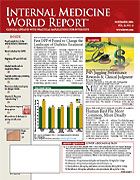Publication
Article
Internal Medicine World Report
Consider Age When Determining CVD Risk in Diabetic Patients
Author(s):
Lancet
Age plays a significant role in determining which patients with diabetes may be at high risk for cardiovascular disease (CVD), according to new data published in the (2006; 368:29-36).
Although this study found that diabetes “ages” a person by approximately 15 years, in general, patients with diabetes who are under 40 years of age appear to be at a lower risk for CVD than commonly thought, according to lead investigator Gillian L. Booth, of the Division of Endocrinology and Metabolism, St. Michael’s Hospital, Toronto, Canada, and colleagues.
Previous data showed that patients with diabetes are more than 4 times as likely to develop CVD as those without diabetes. It has been widely believed that adults with diabetes are at a high risk for CVD regardless of their age.
In 2005, the International Diabetes Federation published guidelines stating that patients aged >40 years with type 2 diabetes should be considered at high risk for CVD, regardless of any preexisting CVD risk factors. And newer data support the benefits of cardioprotective drugs (ie, lipid-lowering agents, aspirin, angiotensin-converting-enzyme inhibitors, and the concomitant use of all of these therapies) in those with diabetes.
This population-based, retrospective, cohort study looked at the health claims of 379,003 adults with diabetes and 9,018,082 adults without diabetes who were living in Canada on April 1, 1994, all of whom were aged ≥20 years. Participants were followed until March 21, 2000, and all CVD events were documented. The majority of those with diabetes were older than those without diabetes (60.8 vs 42.6 years, respectively). A total of 573,515 patients had ≥1 outcome events during the study period, 18.3% of whom had diabetes.
The rate of acute myocardial infarction (MI) increased with age in both groups. Diabetes was associated with earlier CVD; both men and women with diabetes were approximately 15 years younger than those without diabetes in the same risk category.
For the outcome of acute MI, stroke, or death from any cause, men and women with diabetes entered the high-risk category at ages 47.9 and 54.3 years, respectively. Age-adjusted rates for acute MI and all-cause mortality were approximately 2 to 4 times higher in men and women with diabetes than in men and women without diabetes or recent acute MI. Acute MI rates showed a sharper increase with advancing age for those without diabetes (hazard ratio [HR], 2.10 per decade) than for those with diabetes (HR, 1.50 per decade).
“Our data suggest that the CVD risk in people with diabetes does not reach the threshold conventionally regarded as high until the early to late 40s, both for men and for women,” Dr Booth and colleagues write. “Our findings challenge present practices that view all adults with diabetes as being at high risk of CVD irrespective of age or diabetes subtype.”
The investigators noted that these results, which show that diabetes confers a comparable risk to aging 15 years, should be applied to current risk algorithms.
Key points
• Diabetes "ages" a patient by approximately 15 years.
• New data challenge present practice that views all patients with diabetes as being at high risk of CVD.
• Watch patients aged >40 years with type 2 diabetes carefully for signs of CVD.
• These data support the benefits of cardioprotective drugs in these patients.





